A Survey Found That the American Family Generates an Average of 17.2
The health-intendance sector is in many ways the near consequential part of the United States economy. It is a fundamental part of people's lives, supporting their health and well-being. Moreover, it matters because of its economical size and monetary implications. The health-intendance sector now employs 11 percent of American workers (Bureau of Labor Statistics [BLS] 1980–2019b and authors' calculations) and accounts for 24 percent of regime spending (Centers for Medicare & Medicaid Services [CMS] 1987–2018; Bureau of Economic Analysis 1987–2018; authors' calculations).[1] Health insurance is the largest component (26 percent) of nonwage compensation (BLS 2019b) and wellness care is i of the largest categories of consumer spending (8.one percent of consumer expenditures; BLS 2019a).
A well-functioning wellness-care sector is therefore a prerequisite for a well-performance economy. Unfortunately, the issues with U.S. health intendance are substantial. The United States spends more than than other countries without obtaining meliorate health outcomes (Papanicolas, Woskie, and Jha 2018). Wellness intendance is growing as a share of the economic system and government budgets in means that appear unsustainable (CMS 1960–2018; Organisation for Economic Co-functioning and Evolution [OECD] 2015). This growth has slowed at times; wellness spending every bit a share of GDP was roughly flat in much of the 1990s, and growth has too slowed to some extent in recent years. Just even if expenditures as a share of GDP plateaued at their current level, they would still represent a massive expenditure of resources. Sixty years agone, wellness intendance was 5 per centum of the U.S. economy, equally can be seen in figure A; at 17.7 per centum in 2018, it was more than than three times that.

This growth represents a range of factors, from new health-care treatments and services to better coverage, higher utilization, and rising prices. Some of these changes are desirable: Every bit a country gets richer, spending a higher share of income on health may be optimal (Hall and Jones 2007).[two] Countries with a higher level of output per capita tend to have a higher level of health expenditures per capita (Sawyer and Cox 2018). In addition, every bit the population ages, health deteriorates and wellness-care spending naturally rises. Finally, if productivity advancements are more than rapid in tradable goods like agriculture or manufacturing than in services like wellness care or teaching, the latter will tend to rise in relative price and as a share of Gross domestic product.[3]
Merely some of the increase in health-intendance costs is undesirable (Cutler 2018). Hire-seeking, monopoly power, and other flaws in health-care markets sometimes result in unnecessary care or in elevated health-care prices. In several of the facts that follow, nosotros depict these factors and how they are shaping health care.
Spending by private and public payers accept both increased. The United States has a health-care organisation that largely consists of private providers and private insurance, but equally health intendance has go a larger part of the economic system, a higher share of health-intendance funding has been provided by government (figure B). Equally of 2018, 34 percent of Americans received their health care via government insurance or direct public provision (Berchick, Barnett, and Upton 2019).

 Equally shown in figure C, health care has doubled as a share of full regime expenditures in the last 3 decades, from 11.ix percent in 1990 to 24.one percent in 2018. This increment comes from the ascension shares of the population enrolled in Medicare, Medicaid, state Children's Wellness Insurance Programs, and veterans' wellness benefits. Policy changes like the introduction of the Medicare prescription drug do good (Part D) in 2006 and a major expansion of Medicaid eligibility in 2014 played important roles. At the aforementioned fourth dimension, spending on discretionary programs like education and research and development have decreased as a share of Gdp (Congressional Budget Part 2020). If wellness expenditures continue to increase as a share of regime spending, the increment will eventually necessitate either tax increases or reduced spending on other important regime functions like public safety, infrastructure, research and development, and education.
Equally shown in figure C, health care has doubled as a share of full regime expenditures in the last 3 decades, from 11.ix percent in 1990 to 24.one percent in 2018. This increment comes from the ascension shares of the population enrolled in Medicare, Medicaid, state Children's Wellness Insurance Programs, and veterans' wellness benefits. Policy changes like the introduction of the Medicare prescription drug do good (Part D) in 2006 and a major expansion of Medicaid eligibility in 2014 played important roles. At the aforementioned fourth dimension, spending on discretionary programs like education and research and development have decreased as a share of Gdp (Congressional Budget Part 2020). If wellness expenditures continue to increase as a share of regime spending, the increment will eventually necessitate either tax increases or reduced spending on other important regime functions like public safety, infrastructure, research and development, and education.

Of class, wellness costs are likewise borne past the private sector. Firms and households in the United States spent x percent of Gdp on health care in 2018. Despite widespread coverage—as of 2018, 91.5 per centum of Americans had either individual or government health insurance for all or part of the year (Berchick, Barnett, and Upton 2019)—many people even so face large and variable out-of-pocket health-intendance costs. In 2017, more 1 in 50 Americans who collaborate with the health-care system have out-of-pocket costs in excess of $v,000, and one in 200 have costs over $x,000.[4] At the other terminate of the distribution, roughly one in 7 have no out-of-pocket costs at all in a given year (effigy D).[v]
The upper end of the distribution of out-of-pocket costs dwarfs the liquid resources of many U.Due south. households, meaning that many people faced with a negative health shock may also discover themselves in financial problem. Negative health shocks tend to be associated with loss of income, thereby compounding the problem (Garcia-Gómez et al. 2013). Unexpected health costs can generate bankruptcies and ongoing fiscal hardship (Gross and Notowidigdo 2011).[6]
In this document, nosotros provide 12 facts well-nigh the economics of U.S. health-intendance, focusing largely on the private-payer system. Nosotros highlight the surge in health-care expenditures and their current loftier level. We note the wide variation of expenditures across individuals—something that necessitates insurance. We document that the United States pays college prices than most countries and that these prices vary widely beyond and within places. We show that a lack of competition and high administrative costs are especially important contributors to loftier expenditures, indicating the need for reforms to reduce costs in the United States. To keep the focus on these issues, we exercise not talk over questions of coverage or of how coverage is provided (publicly or via the market), just instead address the questions of why expenditures, costs, and prices are so high.
This assay aims to promote The Hamilton Project'southward mission to support broadly shared economic growth. Removing backlog costs from the health-care organization is both an economic imperative and a complement to policy efforts to meliorate health-care access and outcomes. In the following facts we provide context for understanding the landscape of policy options for reducing costs in the health-care system.
Fact i: U.S. per capita health-care spending almost quadrupled from 1980 to 2018.
Spending on U.S. health care has grown steadily, ascent from $2,900 per person in 1980 to $eleven,200 per person in 2018 (measured in 2018 dollars)—a 290 percentage increase (effigy 1a). That growth has slowed at times, as in the mid- to late 1990s and early 2010s, but since 1980 it amounts to annualized growth in real per capita spending of 3.six percent. From 2005 to 2018, growth has been slower (2.0 percent per yr).
A modest role of the reason for this growth is the aging of the U.S. population. Every bit shown in figure 1b, the Usa spends $18,100 on personal health treat an average person 65 to 84 years one-time and $35,000 on an average person 85 or older, while only spending $four,000 on an average person eighteen or younger.[7] Every bit the share of those 65 and older has risen, health-intendance spending per capita has increased accordingly. But this aging-related increase is only a small portion of the overall rising in spending: if the pattern of spending by age had remained constant at 2014 levels, the aging that took place from 1980 to 2014 would have led to a 34 percent rising in per capita spending—far below the 250 percent total increase over that aforementioned period.[8] In addition, as average age has increased, underlying health conditions like obesity have gotten worse over time, necessitating increased wellness-care expenditures (Paez, Zhao, and Hwang 2009; Cawley and Meyerhoefer 2012).
Some of the increase just reflects the growing spending that takes place as per capita income grows, and some comes from innovations that bring new health-intendance services and products. Still, the phenomenon called Baumol's cost affliction describes how sectors with relatively low productivity growth (like health intendance) tend to feel rising costs (Baumol and Bowen 1965; Baumol 2012). Only understanding why health care has had little productivity growth relative to the rest of the economy is important (Sheiner and Malinovskaya 2016). Equally we explore in subsequent facts, problems with health-care markets take contributed to rapidly rising costs in recent decades.
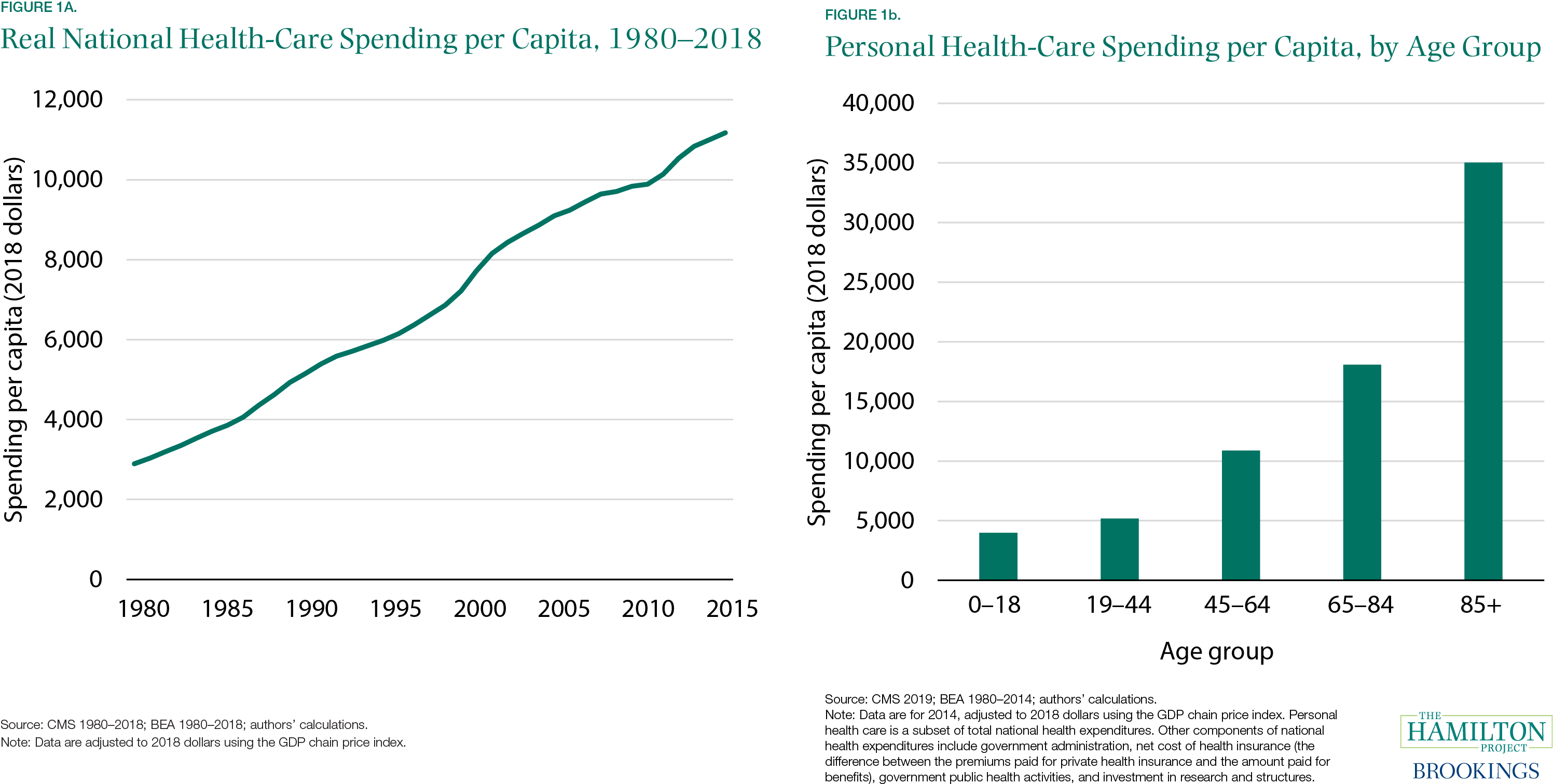
Fact 2: U.South. health-care spending is almost twice as high as the OECD average.
The Usa spends much more on health intendance as a share of the economic system (17.1 percent of Gdp in 2017, using data from the World Health Organization [WHO][9]) than other large advanced economies like Germany (xi.2 percentage) and the Great britain (9.6 percent). Public spending by the U.s.a. (viii.iii pct of Gross domestic product) is roughly similar to public spending by other countries; it is only when private spending is added that the United States far exceeds peer nations (see figure 2). However, public health insurance in the United States covers simply 34 per centum of the population, much less than the universal coverage in countries similar Canada and the Uk (Berchick, Barnett, and Upton 2019; OECD 2020b), indicating that it costs far more to provide coverage in the U.South. organization than around the world.
Figure ii distinguishes spending on the basis of the ultimate payer, such that authorities payments to private providers are counted as public spending. About all U.S. health intendance is privately provided, and 51 percent of spending is paid for by families, nonprofits, and businesses. This is in dissimilarity to those countries that also rely largely on private providers but accept the authorities as the payer (due east.g., Canada) and those countries that rely both on public health-care providers and public funding (e.g., the United Kingdom). Note that the countries shown in effigy 2 are high-income, advanced nations with near-universal health coverage, pregnant that the gap in spending is not primarily explained by differences in coverage rates or income levels, only rather by differences in health-care institutions and policy.
What practise Americans go for their additional health-care spending? In the The states, life expectancy at birth is the lowest of the countries in figure 2; maternal and baby mortality are the highest (Papanicolas, Woskie, and Jha 2018).[10] Certainly, other non-health-intendance factors contribute to these outcomes, but poor U.Southward. performance stands in striking contrast to its high spending on health intendance (Garber and Skinner 2008).
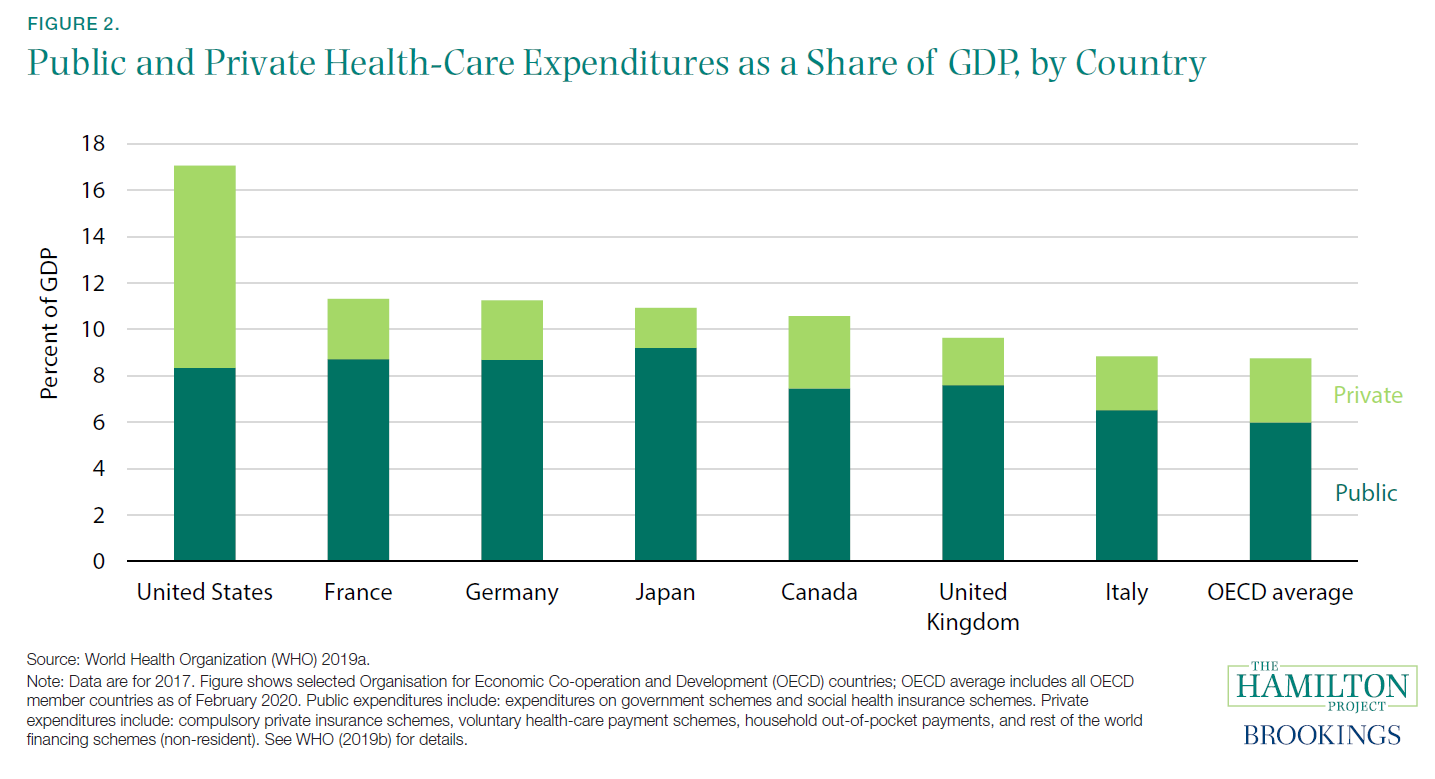
Fact three: Most health-care spending is on hospitals and professional person services.
U.S. health-care spending is high and has increased dramatically in recent decades. But what does the U.s.a. purchase with all this spending?
Roughly a third of all health-care spending goes to infirmary care (effigy 3), making clear that the operation of the U.S. hospital system is crucially important when health-intendance expenditures are considered. Professional services make up roughly a quarter of spending. (Professional services are those provided by physicians and nonphysicians outside of a hospital setting, including dental services.) The combination of long-term care, nursing intendance facilities, and home health care account for thirteen percent of total health expenditures. Prescription drugs are next at 9 percent, and internet health insurance costs (i.due east., premiums earned less benefits paid) account for seven percentage of full spending.
Insurance covers these different expenditures to varying degrees. Consequently, out-of-pocket spending looks somewhat different than overall spending: the largest shares of out-of-pocket spending go to professional services (38 percent of total out-of-pocket spending) and prescription drugs (13 percentage) (CMS 2018 and authors' calculations).[11] Because prescription drugs are an ongoing expense for many, and given the immediate and direct wellness impact that often results from a lack of access, the costs of prescription drugs can dominate health-care price discussions. Nonetheless, for individuals (and especially for the arrangement as a whole), the expense of professional services is much larger.
Much health spending consists of labor costs, rather than capital investment. One written report of physicians' offices, hospitals, and outpatient care establish that labor compensation accounted for 49.eight percent of 2012 health-care revenues (Glied, Ma, and Solis-Roman 2016). Lowering these labor costs requires some combination of increased labor supply, (east.thou., more wellness-care professionals), fewer restrictions on what nonphysicians are permitted to practice (Adams and Markowitz 2018), and reductions in unnecessary services.
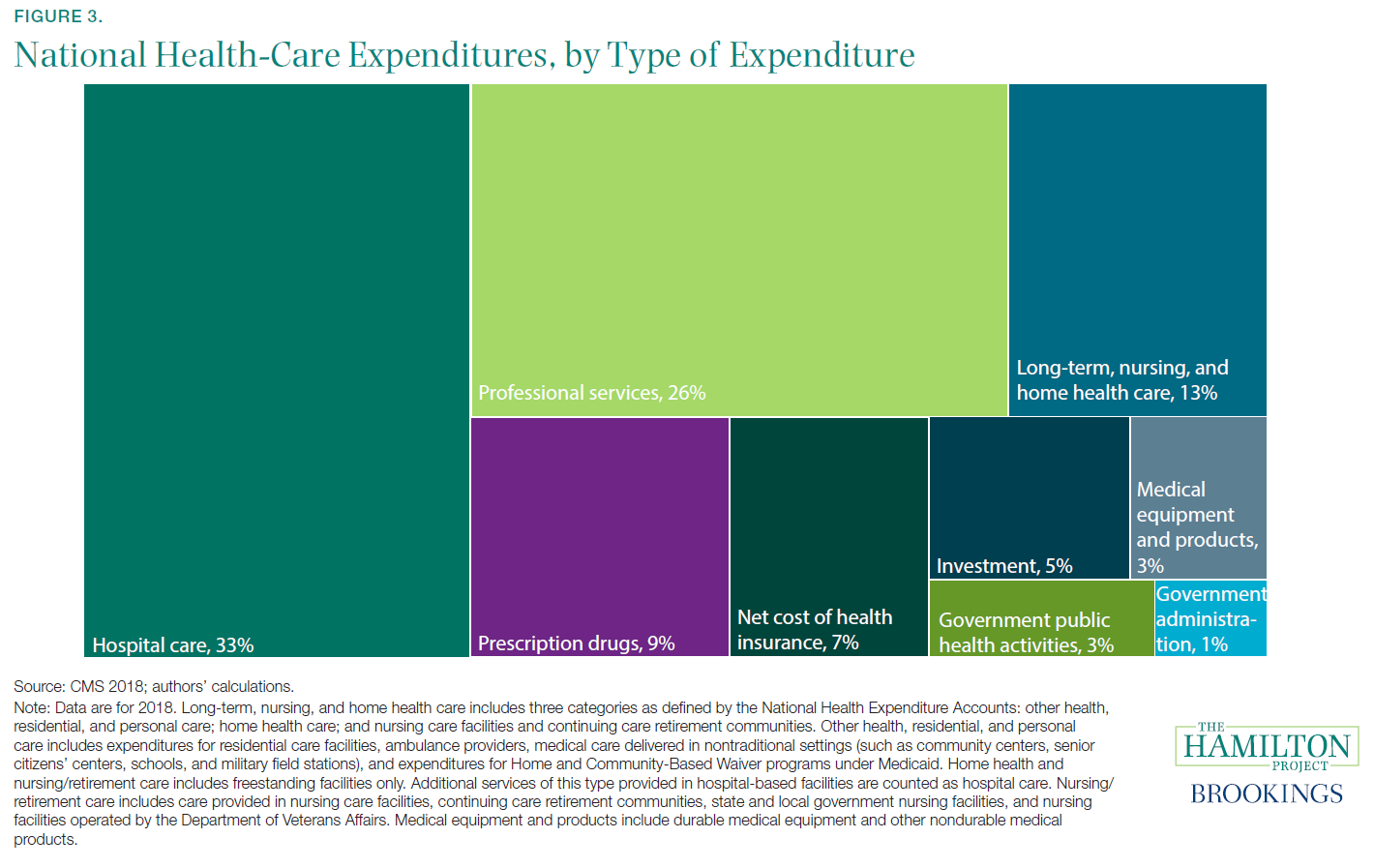
Fact 4: V percent of Americans accounted for half of all U.S. health-care spending in 2017.
Wellness-care spending in whatever given yr is distributed very unequally. The half of the population using the to the lowest degree wellness care accounts for only 3 percent of total (non just out-of-pocket) expenditures (excluding long-term care and some other components of spending),[12] while the top 1 per centum accounts for 22 percent (figure 4).
One reason for this is that health misfortunes can strike at random, causing i-year expenditures to fasten. In any given twelvemonth the distribution can be very diff, but only some of those with the highest spending will continue to take high spending in subsequent years (Cohen and Yu 2012). The bottom half of health-care users are disproportionately young and consequently less probable to demand expensive health care (just apt to need it later in life). Many people volition incur high finish-of-life expenditures—such costs accounted for xiii percent of personal health-care costs in 2011 (Aldridge and Kelley 2015)—simply in any given year most people do not incur these costs. Besides, at 13 percent, end-of-life care is of import but non a ascendant part of U.S. health-care costs.[13]
When individuals incur high costs, insurance is usually necessary to forestall extreme financial hardship. The acme 1 percent have mean health-care expenditures of over $100,000, and the side by side 4 percent have an average of $37,000—expenses that are well beyond power to pay for many families. At the same fourth dimension, the existence of insurance means that patients carry less financial responsibility for the price of their care and accept less incentive to control costs. In other cases—such every bit emergencies—patients are ofttimes unable to compare costs or weigh prices. Both of these features mean that normal downward pressures on prices may not operate in the standard mode in a health-care market.
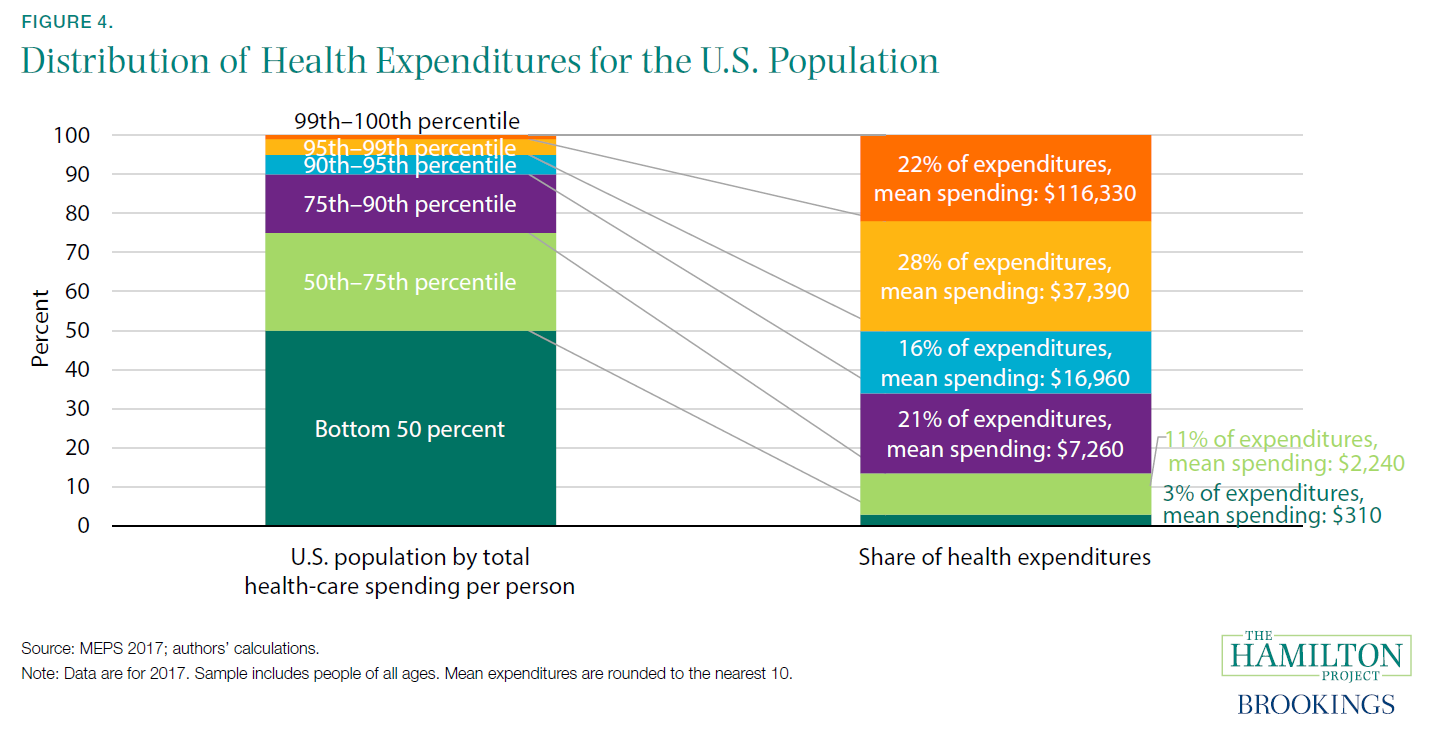
Fact 5: Expenditures are high and variable for those with the poorest health.
Self-reported health is a well-established summary mensurate of a person's health that reliably correlates with objective health measures like laboratory biomarkers (Schanzenbach et al. 2016). We use information technology in effigy 5 to explore how the level and variation in health-intendance expenditures (total, rather than out-of-pocket) differ beyond people of varying wellness conditions.
People enjoying good health are, unsurprisingly, not a major driver of health-care expenditures. Among those who report excellent health, fifty-fifty those at the 90th percentile of expenditures incur just $five,780 in annual spending, not far above the average of $ii,350 for that group. On the other end of the spectrum, people who report being in poor health have average health-care expenditures of $26,450.
More striking is the dramatically college range of expenditure levels for those in poor health. People at the 90th percentile of expenditures (for those in poor health) accept nearly $70,000 spent on their behalf. Conversely, the 10th percentile of those in poor wellness accept merely $700 in expenditures, or 100 times less than the 90th percentile.
The grouping of people who study poor health as well as low health-care expenditures may have health problems that are not resolvable through expensive medical services, only they may also be medically underserved, whether because of a lack of insurance or other reasons (Cunningham 2018). Regardless, health status alone may not always exist a good guide to expected expenditures in a given twelvemonth.
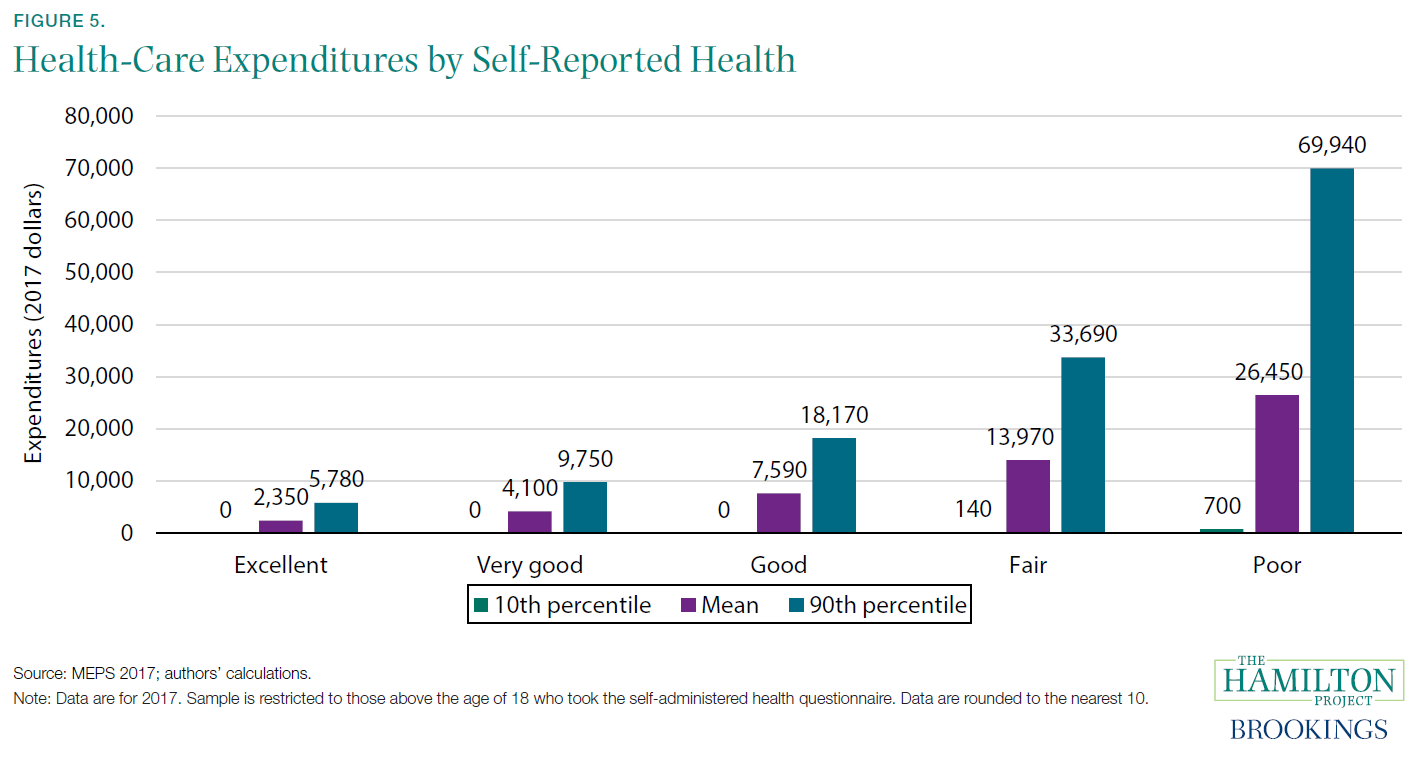
Fact 6: Health-intendance spending per privately insured person is three times higher in some parts of the country than in others.
Some places in the United states have considerably higher health-care spending than others. This is not primarily a matter of elderly people being disproportionately represented in certain areas. Figure 6 shows spending per privately insured beneficiary after adjusting for differences across places in age and sex (Cooper et al. 2019). The upper Midwest, much of the east declension, and northern California are all notable as places with peculiarly high spending.
In a comparison of so-chosen hospital referral regions (i.eastward., regional health care markets), spending per privately insured beneficiary is about iii times higher in the highest-spending region ($6,366 in Anchorage, Alaska) than in the lowest-spending region ($2,110 in Honolulu, Hawaii). Roughly half of the overall variation is associated with differences in prices across regions, with the other half due to differences in the quantity of wellness intendance consumed. Surprisingly, a significant amount of the national variation in prices occurs within hospitals (Cooper et al. 2019).
Medicare spending is somewhat different: prices are set administratively rather than through decentralized negotiations between payers and providers. Most of the geographic variation in Medicare spending is accounted for by differences in health-care utilization across places—particularly in post-astute care—rather than by prices (Cooper et al. 2019). Further, about half of the variation in utilization is driven by demand-side factors like health and preferences, simply differences in supply beyond places are also important (Finkelstein, Gentzkow, and Williams 2016).
Is this spending variation evidence of a problem that policy should address? The answer (and the policy response, if one is called for) depends on whether spending is specially loftier in some places because of insufficient contest and related market failures (Cooper et al. 2019), differences in physician beliefs (Cutler et al. 2019), a larger share of people with expensive health weather condition (Rosenthal 2012), or a higher price of living and other factors not straight related to the functioning of health markets.
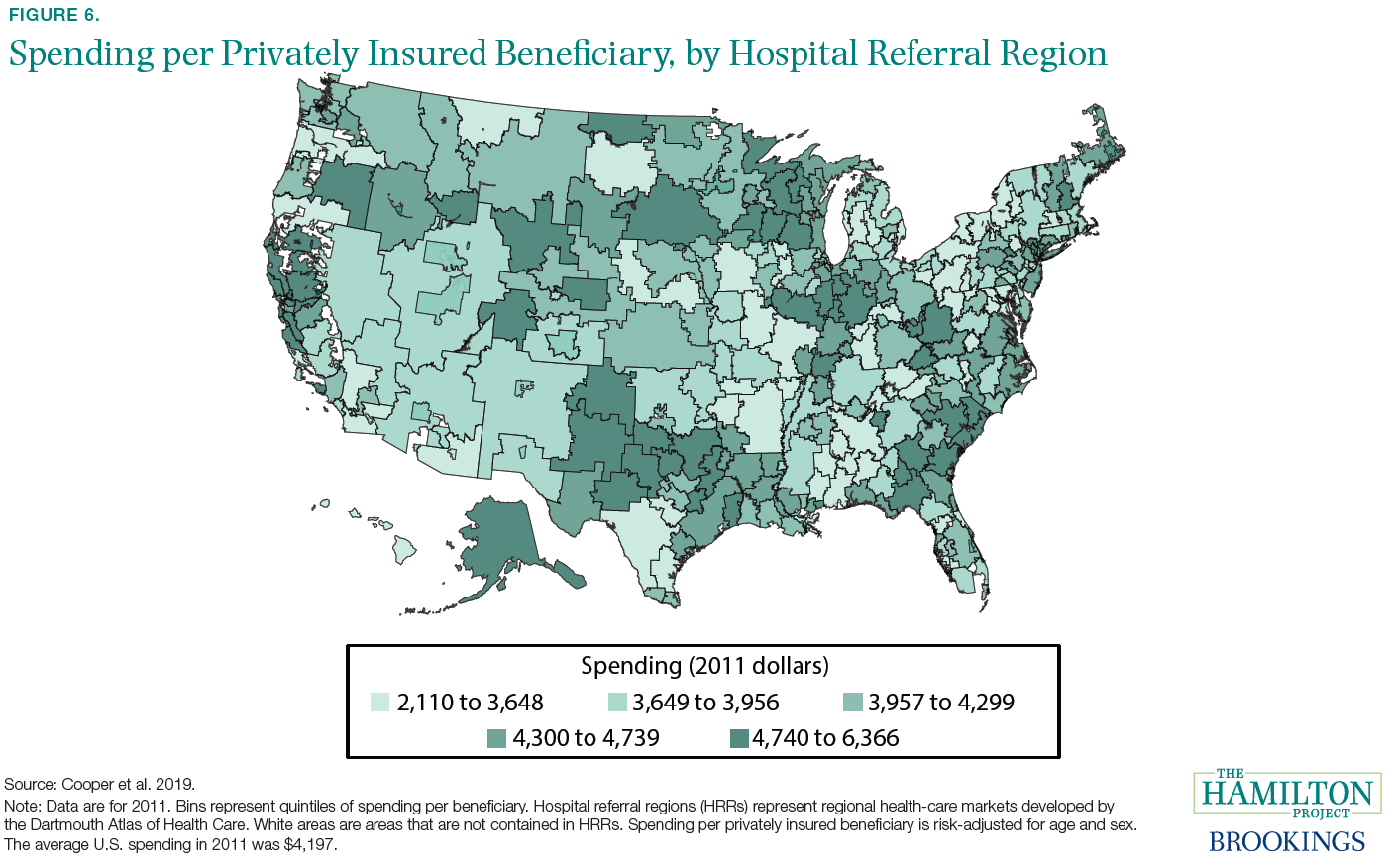
Fact 7: In many cities, health-intendance prices vary widely for the same service.
In a well-performance competitive market place, prices for the same service will not vary widely inside a given place: consumers volition avert a business that charges much higher prices than its competitors. However, many wellness-care markets dramatically violate this expectation. Figure 7 focuses on health-intendance cost variation within selected metro areas, showing that some metropolitan statistical areas feature much more toll variation than others. For example, estimates from the Health Intendance Cost Institute testify that the price for a blood examination ranges from $22 (10th percentile) to $37 (90th percentile) in Baltimore, Maryland, but in El Paso, Texas, the same range is $144 to $952. For a C-section delivery, prices vary widely both across and within markets: the 10th to 90th percentile range is 9.3 times larger in the San Francisco, California, metro area than in the Knoxville, Tennessee, metropolitan area.
Some variation in prices is due to differences in quality and amenities: one medical practice might take more time with patients, have nicer facilities, or utilise more experienced medical teams, allowing it to charge correspondingly college prices. Just much of the variation is probable related to market imperfections that limit the power and incentive for patients to shop for the lowest price (Chernew, Dafny, and Pany 2020; Tu and Lauer 2009; Mehrotra et al. 2017).
A Hamilton Project proposal by Michael Chernew, Leemore Dafny, and Maximilian Pany (2020) would accost this type of wellness-care toll dispersion with regulatory interventions directed at the well-nigh egregious price growth.
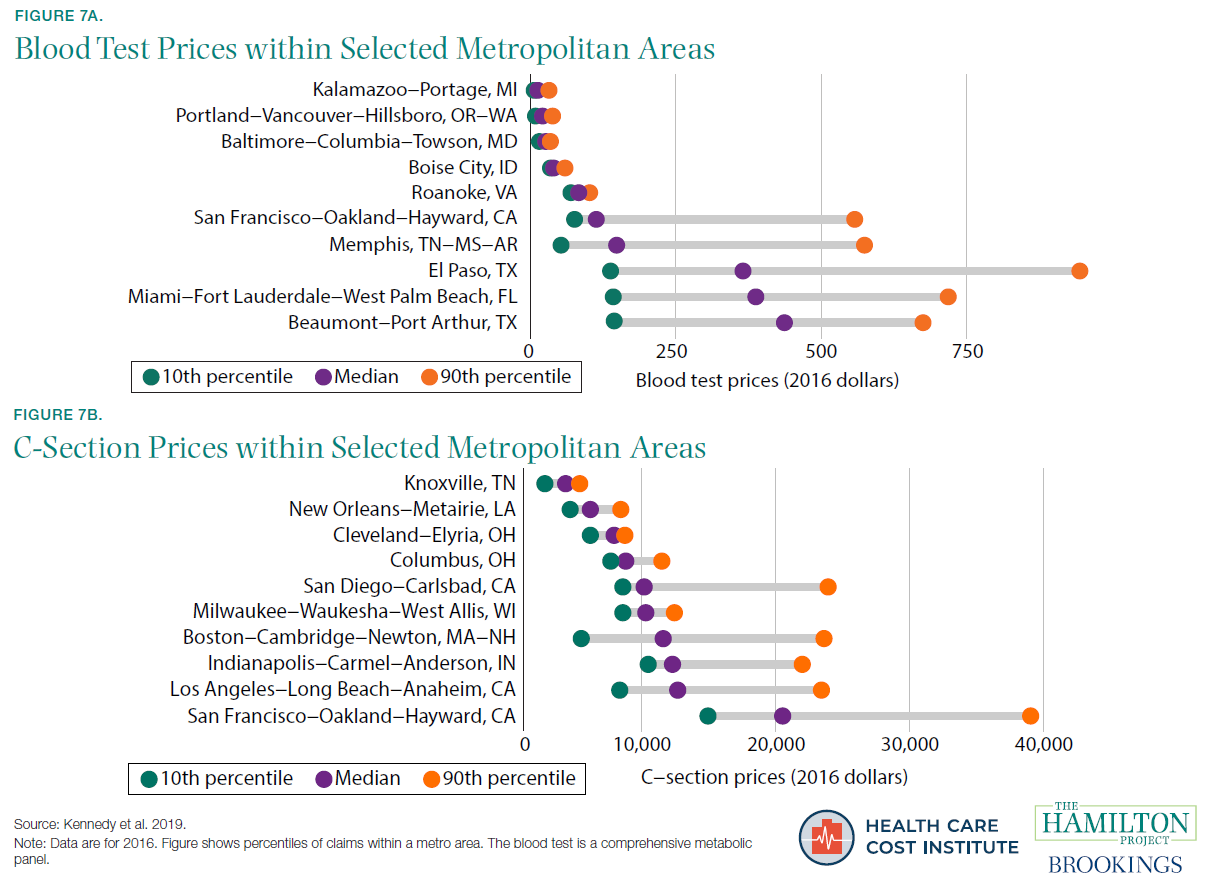
Fact 8: The U.s. pays more than for wellness-care services than other avant-garde economies.
The United States has dramatically higher health-intendance prices than other advanced economies. This is the case for surgical procedures, diagnostic tests, prescription drugs, and almost any other type of health-care service. Figure 8 shows seven other countries' prices, as a percentage of the U.S. cost, for selected health-care services (Hargraves and Bloschichak 2019). For example, a Humira Pen costs between 16 percentage (South Africa) and 35 pct (Germany) of the U.Due south. average price.
Relatively high U.South. prices are not just about college prescription drug prices (the bottom panel of figure 8) and the implicit subsidies that the United States provides to the residual of the globe (much of which imposes toll controls on prescription drugs) past paying the stock-still costs of drug enquiry and development (Wagner and McCarthy 2004). The United States also has higher prices for outpatient procedures like colonoscopies, MRIs, and cardiac catheterization, and infirmary procedures like C-sections and bypass surgeries (Hargraves and Bloschichak 2019). For example, a hip replacement surgery costs between 21 pct (Holland) and 64 per centum (Commonwealth of australia) of the average price in the Us.[14] These patterns are consequent with research showing that high U.S. prices are an important part of high U.Southward. spending on health care (Papanicolas, Woskie, and Jha 2018).[fifteen]
High prices betoken underlying concerns that are different than those indicated by high use of health care. In particular, prices and so far higher up those in other countries tin can reverberate rents (i.e., payments to the wellness-care organisation beyond what is necessary for a normal rate of turn a profit). These rents are driven by market imperfections including provider market power and the difficulty that health-intendance patients and other payers have in assessing prices and quality (Chernew, Dafny, and Pany 2020). In addition, excess administrative costs (see fact 10) and generally higher wages for highly educated workers in the United States contribute to relatively high U.Southward. prices.

Fact ix: Market concentration is loftier for specialist physicians, insurers, and specially hospitals.
1 reason for high prices and high health-care costs is that competition is unusually weak in the wellness-care organisation. Consolidation of medical providers, barriers to market place entry, and the closing of some hospitals have led to high and rising market concentration, which allows providers to set higher prices without losing patients.
Figure nine describes this situation in terms of a commonly used concentration metric called the Herfindahl-Hirschman Index (HHI). This index captures the degree to which marketplace share is concentrated in a few organizations, and it is an important assessment tool for antitrust policy. Under the Department of Justice/Federal Trade Commission Merger Guidelines, an HHI of 1,500 indicates a moderately concerning concentration level, and an HHI of 2,500 indicates high concentration. As shown in the figure, insurers, specialist physicians, and hospitals are all above this latter threshold, with hospital concentration peculiarly loftier (with an HHI of 5,790 in 2016). Chief care physicians are between the moderate and high concentration levels, but they have experienced a rapid increase in HHI every bit private practices have been acquired (Capps, Dranove, and Ody 2017; Capps, Dranove, and Ody 2018; Fulton 2017).
Figure 9 shows mean HHI across metropolitan areas, rather than the national level. It therefore does not increase when a infirmary in New York merges with a hospital in California, for instance. While this is appropriate for understanding the range of choices available to a patient, information technology does not capture the deleterious effects of consolidations across geographic areas (Dafny, Ho, and Lee 2019; Lewis and Pflum 2017). As explained in Gaynor (2020), hospitals that consolidate across areas gain leverage in negotiations with insurers, who prefer to offer large employers a health plan that includes many provider options throughout the The states.
Reversing consolidation that has already occurred is probable to be difficult. Just policymakers can take steps to prevent boosted consolidation—and promote competition in other ways—equally described in a Hamilton Project proposal by Martin Gaynor (2020).
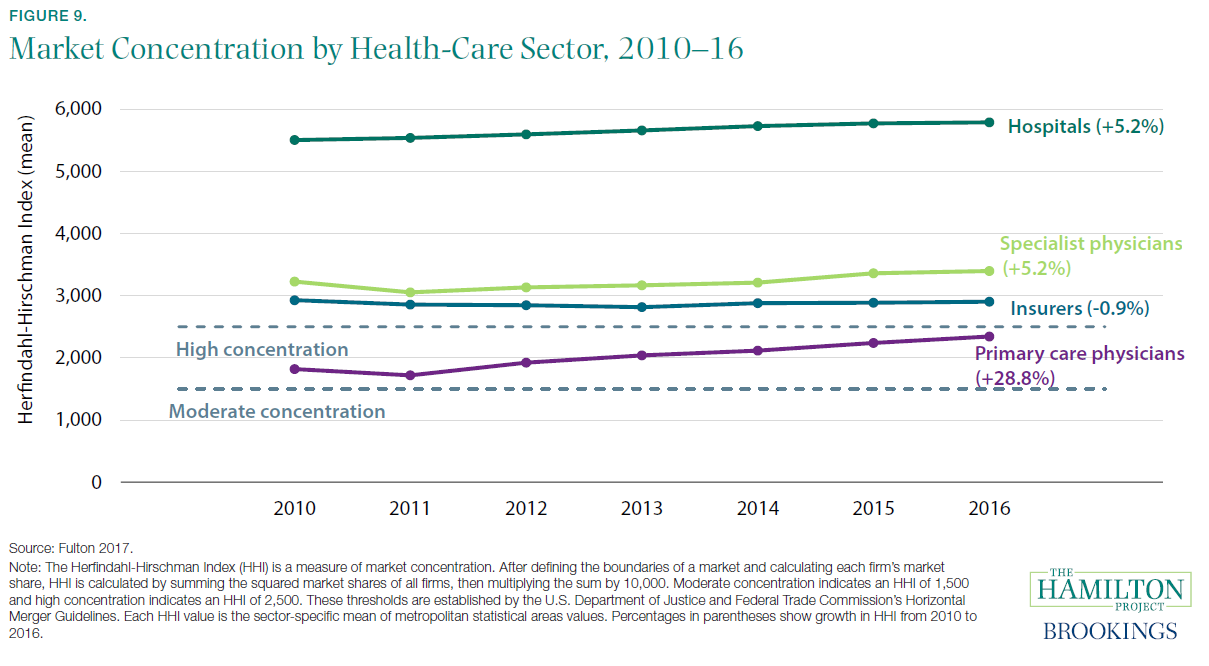
Fact x: U.S. health-care administrative costs are the highest of all advanced economies.
Administrative health-care costs are higher every bit a share of GDP in the United States than in other countries. These administrative (i.e., nonclinical) costs take several forms: claims processing and payment, prior dominance and eligibility determinations, and quality measurement, amongst others. While a certain amount of this administrative expense is inevitable and necessary for a well-functioning system, public or private, the excess of U.S. costs over those of other avant-garde economies is part of the explanation for high U.South. health-intendance costs overall (Cutler and Ly 2011).
Figure 10 shows two different estimates of administrative costs in the wellness-care systems of the U.s.a. and several other countries. The OECD estimates include only payers' costs to administer health benefits and coverage, while the estimates by Himmelstein and coauthors include only administrative costs to hospitals (OECD 2020a; Himmelstein et al. 2014).[xvi] The differences between the United States and other countries are notable. The Usa spent 1.iv percent of GDP on infirmary administrative costs in 2010, compared with 0.viii percent in the netherlands and merely 0.4 percentage in Canada. On the payers' side the United States is too an outlier, spending i.2 percent of GDP on payers' administrative costs, compared with just 0.two per centum in the United kingdom.
I reason for administrative costs is to reduce non-administrative costs related to excess use of health-care services. For example, prior-potency requirements can reduce costs and limit use of the most expensive drug options (Soumerai 2004). However, these requirements impose costs on patients and providers that must be taken into business relationship, and in some cases they may simply reflect a battle over who pays for necessary procedures.
Administrative costs cannot and should non be completely eliminated, even in a public system like the Britain's, only they can exist affected past policies and practices. In a Hamilton Projection proposal, David Cutler (2020) describes reforms that would reduce authoritative costs without impairing important functions of the wellness-care system.
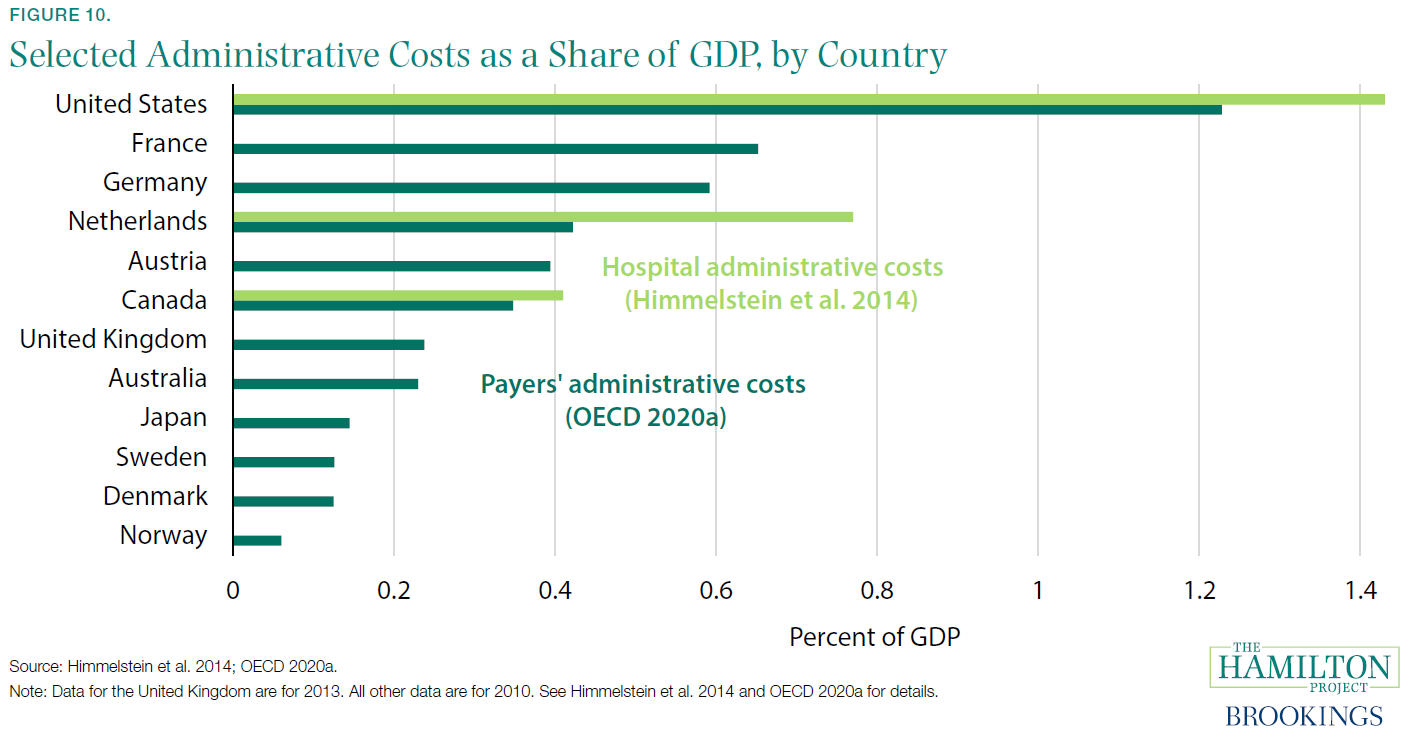
Fact 11: U.S. doctor labor supply is tightly restricted.
Health-care providers take become a larger share of the labor force, rise from 5.0 percent of employment in 1980 to viii.5 percentage in 2019 (BLS 1980–2019b and authors' calculations).[17] All the same, labor supply has been limited in of import ways. In effigy 11a, we show the rate of medical residency positions per 100,000 U.S. residents that were available over the last sixty years. These positions are a necessary office of physician training, required just after medical school. Historically the federal government has heavily subsidized a certain number of residency positions (Heisler et al. 2018); hospitals take been reluctant to provide many residencies without subsidy.
From 1960 through 2010, per capita medical residency positions increased only slightly, rising from 6.9 to 7.four per 100,000 people. A more than rapid increase occurred since 2010 as a number of osteopathic programs entered the data, bringing the charge per unit to 9.8 in 2019 (about 32,000 total positions), merely nevertheless beneath the application rate.[18]The flat rate—contrasted with rising expenditures and health-care needs for an aging and richer population—suggests that limited supply has been a problem.
In health-intendance occupations more often than not, training requirements have steadily risen. In 2000, for instance, physical therapists were required to take either a four-yr degree or a master's degree in every state. By 2015, 43 states required that they obtain a doctorate caste to exist legally permitted to practice (Cai and Kleiner 2016).[19]
Express labor supply contributes to high wages, which in plough contribute to high health-intendance prices in the United States[20] As shown in figure 11b, the median almanac income of U.S. physicians is $199,500, well above the 90th percentile of overall income ($126,900). In 1980 the typical physician earned 3.27 times the median wage for all workers, compared with 3.84 times today. Growth in physicians' salaries has coincided with the general rise in inequality at the pinnacle of the earnings distribution. In comparison with other advanced economies, U.S. physicians earn considerably higher salaries than their counterparts (Kane et al. 2019; Peterson and Burton 2007).

Fact 12: Surprise billing is associated with high health-intendance costs.
In a well-operation market place, consumers are able to observe price and quality differences between unlike options. Health-care markets often fail to meet this standard. One striking way in which they neglect is a practice called "surprise billing," when insured patients discover out (after receiving health-care services at an in-network facility) that a provider (east.yard., a surgeon in the emergency department or the anesthesiologist administering an epidural during childbirth) was exterior of their insurance network and is consequently much more expensive than they had predictable. This raises costs to consumers and likewise allows providers to charge higher prices than those that were negotiated past insurers, raising overall costs.
Effigy 12 shows that surprise billing is very common when patients utilize ambulance services (51–69 percent) or the emergency department visits (xix–22 percentage), and somewhat common even when receiving elective hospital care (9 percent).[21] Surprise billing in emergencies presents special problems: patients and their families have little or no ability to compare prices and cull the best selection even if they are aware of the prices they face up.
Moreover, health insurance cannot part as insurance if patients frequently incur extraordinarily big (and unexpected) bills when the need for expensive medical procedures arises, nor can insurers bargain down prices on behalf of their beneficiaries. Surprise billing is indeed associated with substantially college medical bills. According to USC-Brookings Schaeffer Initiative for Health Policy calculations, the medical providers who often have the ability to engage in surprise billing—practitioners in anesthesiology, emergency medicine, diagnostic radiology, and pathology, for instance—tend to charge big multiples of Medicare immune amounts. Hateful charges for emergency medicine are 5.4 times higher than Medicare rates, for case, compared with a 2.2 multiple for master intendance (Adler et al. 2019), which is more likely to be in-network and have prices negotiated by an insurance program.
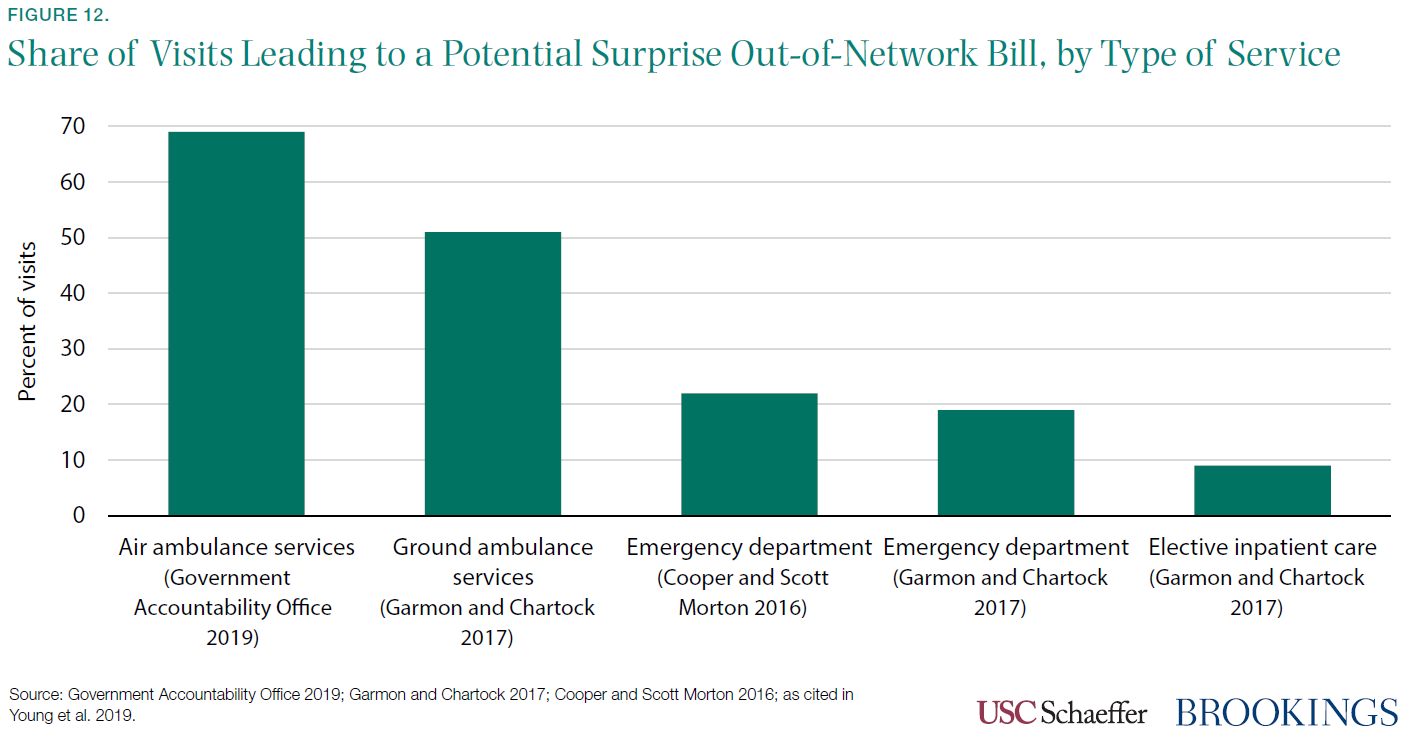
Endnotes
[one] The share of health-care employment refers to the share employed by the health-care manufacture.
[two] However, see Acemoglu, Finkelstein, and Notowidigdo (2013) for a contrasting view. They find that the income elasticity of health intendance is likely below one.
[3] This dynamic is referred to as Baumol'due south cost disease and reflects the need for service-sector wages to keep pace with rising wages in the sectors with high productivity growth.
[4] These calculations employ the Medical Expenditure Panel Survey (MEPS), which excludes long-term care and other components of wellness-care spending that are included in the national health intendance expenditure accounts (NHEA) information from Centers for Medicare and Medicaid Services (CMS) used elsewhere in this document. These excluded expenditures could be distributed unevenly across the population and tin can therefore bear upon the patterns shown in figures based on MEPS information. For more on a comparison of the types of spending covered in the MEPS and spending covered in the NHEA, which is used in other figures in this certificate, run across Bernard et al. (2012).
[5] Loftier-deductible plans accept sometimes been suggested every bit a mode to increase the sensitivity of patients to health-care prices. However, these plans seem to pb patients to reduce their spending indiscriminately, cut valuable and less-valuable intendance akin (Brot-Goldberg et al. 2017).>
[6] Still, it is important non to overemphasize the office of health expenses in generating bankruptcies; contempo enquiry suggests that hospitalizations of uninsured adults generate only nigh half-dozen per centum of bankruptcies for that group (Dobkin et al. 2018).
[7] Data are for 2014, the about recent year for which spending information past age are available from CMS, and are adjusted to 2018 dollars using the GDP chain price index. These per capita costs are for personal wellness-care spending, which is a subset of the full spending presented in figure 1a and excludes government administration, net cost of health insurance (the difference between the premiums paid for private health insurance and the amount paid for benefits), government public health activities, and investment in research and structures.
[viii] This calculation focuses on the 1980 to 2014 period, rather than 1980 to 2018, due to limited data on spending by age.
[nine] This estimate for the United States is slightly lower than that shown in figure A, which is based on information from CMS.
[x] This comparing excludes Italy, which is non included in Papanicolas, Woskie, and Jha (2018).
[11] In the MEPS, which excludes long-term care and other components of health-intendance spending that are included in the national health care expenditure accounts data from CMS, both out-of-pocket and total spending on prescriptions are roughly 25 percent of total out-of-pocket spending and full expenditures, respectively.
[12] The MEPS excludes long-term care and other components of health-care spending that are included in the national wellness intendance expenditure accounts data from CMS used elsewhere in this document. These excluded expenditures are likely distributed unevenly beyond the population and tin therefore bear upon the patterns shown in figures based on MEPS information. For more than on a comparing of the types of spending covered in the MEPS and spending covered in the NHEA, which is used in other figures in this document, come across Bernard et al. (2012).
[13] It is non always clear in advance that such care is cease-of-life—in other words, the hope is that patients volition recover equally a result of the care. As such, the amount spent knowingly at the end of life is even lower (Einav et al. 2018).
[14] It is not surprising that the United States has college prices than poorer countries. The Balassa-Samuelson effect notes that high-income countries have higher prices for non-traded goods and services (like health care) than low-income countries (Balassa 1964; Samuelson 1964). But the Balassa-Samuelson result does not predict much variation among high-income countries, and nonetheless the United States is conspicuously at the upper end of the price distribution for health care.
[15]Other studies of international price differences have sometimes found the U.s.a. to exist less of an outlier, but however high. For case, i survey found that U.S. hospital service prices are simply xxx percentage college than the OECD average and merely slightly higher up those of countries similar Canada and Republic of austria (Lorenzoni and Koechlin 2017).
[16] Neither of these estimates includes administrative costs to providers. Thus, these calculations embody a different accounting of authoritative costs than is cited in Cutler (2020), and the estimated fractions of wellness-care expenditures are substantially lower.
[17] Health-care providers' share of the labor strength refers to health-intendance occupations.
[18] Equally described by the American Medical Association, "The number of available outset-year (PGY-ane) positions rose to 32,194, an increase of 1,962 (6.5 per centum) over the prior year. That increment in opportunity reflects the growth in the number of osteopathic programs joining the Primary Residency Friction match as a result of the ongoing transition to a unmarried accreditation organization for graduate medical education (GME) programs" (Spud 2019).
[19] Calculation courtesy of Morris Kleiner.
[20] However, it is less clear what express health-intendance labor supply implies for service use, which may diminish when labor supply is restricted.
[21] Surprise billing is also more than likely when a health programme has no in-network options at a infirmary in a particular provider category. In a study of Texas hospitals, between 21 pct and 56 percent of in-network hospitals had no in-network emergency physicians, depending on the health program (Hall et al. 2016, citing Center for Public Policy Priorities 2014).
Source: https://www.brookings.edu/research/a-dozen-facts-about-the-economics-of-the-u-s-health-care-system/
0 Response to "A Survey Found That the American Family Generates an Average of 17.2"
Post a Comment